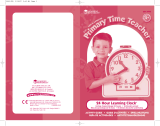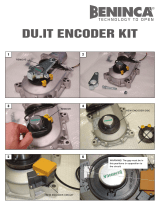Page is loading ...

LER 1776
Building Set
LER 1776
5
+
K
+
Ages • Años
Ans • Jahre
Juego de construcción de figuras geométricas
Kit de construction de formes géométriques
Bauset mit geometrischen Formen
170
Pieces
• Piezas • Pièces • Teile
© Learning Resources, Inc., Vernon Hills, IL, US
Learning Resources Ltd., Bergen Way,
King's Lynn, Norfolk, PE30 2JG, UK
Please retain our address for future reference.
Made in China. LPK1776-LBL
Hecho en China. Conservar estos datos.
Fabriqué en Chine. Informations à conserver.
Hergestellt in China. Bitte bewahren Sie unsere
Adresse für spätere
Nachfragen auf.
Building Set
Juego de construcción de figuras geométricas
Kit de construction de formes géométriques
Bauset mit geometrischen Formen
170
Pieces
• Piezas • Pièces • Teile
Designed to Meet CCSS:
Geometry
Includes curves
for building
circles, cylinders,
and spheres!
Includes:
• 30 Small sticks • 32 Curves
• 36 Medium sticks • 24 Red connectors (8 holes)
• 24 Large sticks • 24 Orange connectors (10 holes)
Get a real crash course in shapes with 170 unique geometric pieces
designed for big, brainy construction! Aligned to multiple CCSS geometry
standards for grades K–2, this bucketful of learning inspires the
imagination with myriad 2-D and 3-D shape-building possibilities, plus
unique curved pieces for making circles, cylinders, and spheres. It’s time to
go to work and get building!
CCSS Alignment:
This product comprehensively targets Common Core State Standards for
Geometry in grades K–2. Visit our website to learn more!
Notes for Use:
• The holes around the circumferences of each connector are spaced
differently. The red connectors have holes 60 degrees apart, and the
orange connectors have holes 45 degrees apart.
• There are enough pieces in this set for approximately 4–8 students to
simultaneously build 2-dimensional shapes, and for approximately 3–4
students to build 3-dimensional shapes.
Getting Started
Before doing the activities, familiarize children with the pieces and their
functions in building common shapes. Show how to connect the pieces
and point out the differences between the two connectors (see Notes for
Use, above). After students have had a chance to explore and build freely
with the pieces, introduce the following activities.
Activities:
Building 2-D Shapes—Build common 2-D shapes such as a square,
triangle, rectangle, hexagon, rhombus, and circle. Start building with
the medium sticks; progress to making similar shapes that are larger or
smaller. For a challenge, try building shapes with different-size sticks. For
example, build a triangle by combining small and medium, or medium and
large sticks. You can build half- and quarter-circles too!
Attribute Analysis—Once students have built several shapes,
compare them by attribute such as number of sides and vertices (or
corners), lengths of sides, and so on. Discuss de ning attributes (e.g.,
number of sides) and non-de ning attributes, such as color, orientation,
and size.
Combining Shapes—Combine simple shapes to make a new shape, in
either two or three dimensions. Some shape combinations include joining
two triangles to make a rectangle, two cubes to make a rectangular prism,
and so on. Note: When combining two shapes that share a side, the
new shape will usually share one stick, rather than requiring the use of
multiple sticks.
Building 3-D Shapes—Build traditional 3-D shapes such as cubes,
prisms, and cylinders. Hint: start with two same-shape bases and connect
them using sticks to add the dimension of height. For a real challenge,
build a sphere!
Shapes in the World—Build 3-D shapes, and then discuss which
real-world shapes they could represent. Also, try combining 3-D shapes
to make recognizable gures: for example, combine a rectangular and
triangular prism to make a house. Be creative—the possibilities are
endless!
Equal Shares—Teach fractions by partitioning 2-D shapes, such
as circles, squares, and rectangles, into two and four equal shares.
Demonstrate with smaller sticks and connectors inside of shapes, or
simply lay larger sticks over the shapes’ faces to easily reposition them
(i.e., you can partition a square into 4 smaller squares or 4 triangles,
depending on position). Describe parts of a whole using terms like halves,
fourths, and quarters, and refer to the partitioned shape in two or four
parts. Also, try partitioning circles, hexagons, and rectangles into thirds!
Juego de construcción de fi guras geométricas
Incluye:
• 24 conectores naranjas (10 agujeros) • 36 varillas medianas
• 24 conectores rojos (8 agujeros) • 30 varillas pequeñas
• 24 varillas largas • 32 curvas
Sobre su uso:
• El juego contiene su cientes piezas para que 4-8 estudiantes contruyan
de manera simultánea formas en 2D, y para que 3-4 estudiantes
construyan formas en 3D.
• Los agujeros alrededor de las circunferencias de cada conector cuentan
con un espaciado distinto. Los conectores rojos tienen agujeros
separados por 60 grados, y los conectores naranjas tienen agujeros
separados por 45 grados.
Introducción
Antes de realizar actividades, permita que los niños se familiaricen con las
piezas y sus funciones en la construcción de guras comunes. Muéstreles
cómo conectar las piezas y señale las diferencias entre dos conectores
(ver Notas de Uso, líneas arriba). Luego que los estudiantes han tenido la
oportunidad de investigar y construir libremente con las piezas, presente
las siguientes actividades.
ES
/













